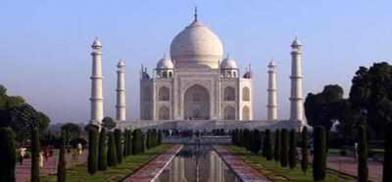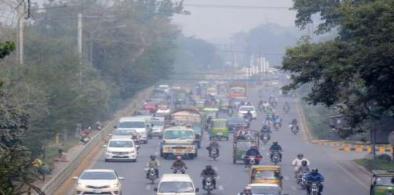Eco-sensitive Taj Trapezium Zone losing war against pollution
Nearly three decades after the Supreme Court's intervention and the continued war against environmental pollution to secure precious world heritage monuments in the Taj Trapezium Zone, conditions are far from improved

Nearly three decades after the Supreme Court's intervention and the continued war against environmental pollution to secure precious world heritage monuments in the Taj Trapezium Zone, conditions are far from improved. With the green cover continuously reducing and water bodies either drying up or heavily polluted, the overall situation is depressing, which points to the utter failure of the government bodies in handling the alarming ecological crisis coming up in the region.
Environmentalist Devashish Bhattacharya says, "The Taj Mahal is neither safe from air pollution nor water pollution. The war against pollution has been lost for lack of commitment and will power at the highest level of governance."
The apex court in 1993 had directed a slew of measures while considering the high-powered Experts Committee, headed by senior scientist S. Varadarajan, a report in the M.C. Mehta-filed Public Interest Litigation (PIL) on pollution threatening the very existence of Taj Mahal. Over the years thousands of crores have been spent without discernible changes to the overall environmental scenario in the 10,400 sq km eco-sensitive Taj Trapezium Zone.
In 2020, Agra fared poorly on the Air Quality Index (AQI). The Ambient Air Quality has gone worse from poor, as Agra continued to be among the top polluted cities in India. The dust level (SPM and RSPM) has risen and the share of poisonous gases in the ambient air has remained high posing a grave threat to people and monuments.
Although, the city claims serious participation in the race of becoming a 'Smart City', the results do not instil confidence or indication of any positive shift in the eco-equilibrium. All parameters suggest Agra is nowhere close to winning the pollution war, despite international concerns and claims of government efforts to halt the increasing pollution levels.
Neither the pollution standards applicable in eco-sensitive zones have been achieved nor has the city made any progress in extending the green cover. The forest area has also reduced considerably to a meagre six per cent or less as against the national target of 33 per cent. The Suspended Particulate Matter (SPM) level remains more than 350 micrograms per cubic metre while recording above 600 during the summer season as against the standard 100 microgram.
The level of toxic gases has continued to rise due to the sudden explosion in number of automobiles. "In the early 1980s when Firozabad was part of Agra district, the number of registered vehicles was only 40,000. But now the number has crossed the million-mark in Agra district alone. With the addition of Firozabad, Mathura and the neighbouring Hathras districts, the scenario is even more frightening," said green activist Shravan Kumar Singh.
It is strange that despite continuous monitoring by the apex court and the National Green Tribunal (NGT), there has not been any significant change in the environmental scenario in the TTZ (Taj Trapezium Zone).
One major source of dust and pollution is the dried and polluted river Yamuna. "The river Yamuna is virtually dead in Agra. The dry riverbed and the highly polluted water that flows down the river pose serious threats to historical monuments along its banks. Despite decades of judicial activism, major policy pronouncements and projects worth millions of rupees, this Taj city remains pockmarked with mounds of garbage. Air and water pollution threaten the health of people and the world-famous monuments visited by millions of tourists every year," Bhattacharya lamented.
The SPM rises as the river bed runs dry and the Rajasthan desert gradually expands into Uttar Pradesh. In recent years, there has also been large-scale illegal stone mining in the Aravalli ranges, pushing up the particulate matter in the air.
Since the STPs (Sewage Treatment Plants) are non-functional, most of the city's sewage is discharged through drains into the river or through borings pumped into the earth. "In the old city areas, one sees sewer overflowing and untreated waste flowing into municipal drains that open into the river Yamuna. The STPs hardly work. Against an installed capacity of 154 million litres daily, the three STPs treat not more than 80 MLD (million litres per day) and that, too, not sewage but 'nullah' (drain) water."
In the 1990s there was hope that the city would transition to a higher level of sustainable development, but the directionless and lethargic bureaucratic machinery is still struggling with a questionable agenda that includes another showpiece, the Agra Metro, along with flyovers, expressways, and rural road networks that have collectively reduced the green cover.
The Supreme Court in its 1996 verdict had directed that several rows of trees be planted on the western periphery of the city to filter the dust-laden westerlies blowing from Rajasthan which has not at all been followed and greenery here has vanished as tall buildings now stand where community ponds once existed. "The builders and colonisers have grabbed all water bodies to build malls and multi-storeyed buildings. Parks have been encroached upon as well. The historical monuments are dwarfed by illegal structures but no one really cares," say members of the 'River Connect' Campaign.
Agra was a showpiece of India's serious intent on waging an environmental war to make monuments breathe freely after an alarm was raised over the setting up of an oil refinery at Mathura in 1974.
But the haphazard growth of the urban clusters in the TTZ has created more problems than the resources could address. The war against directionless urbanisation has been lost before beginning.
(IANS)












Post a Comment